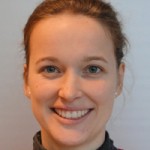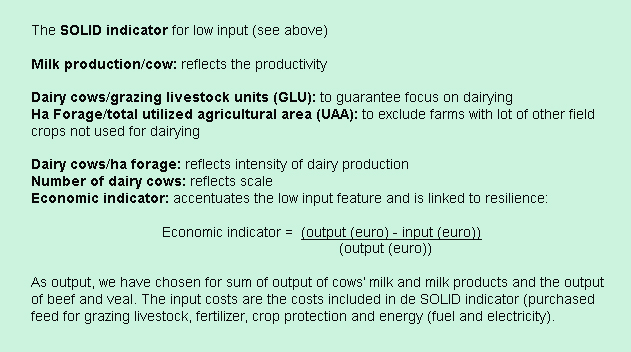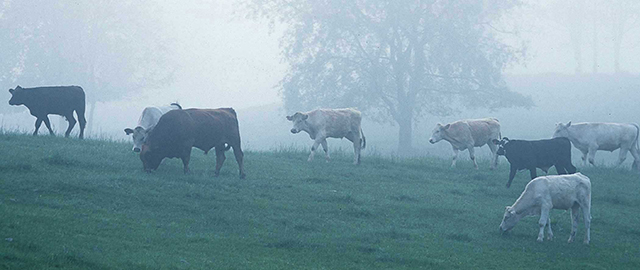 Tuning a consistent information flow between models is a main challenge, since huge variation exists across countries. WP6 has created a new definition and characterization of a typical low input dairy farm, intending to be a better anchor for information flow between different modelling levels.
Tuning a consistent information flow between models is a main challenge, since huge variation exists across countries. WP6 has created a new definition and characterization of a typical low input dairy farm, intending to be a better anchor for information flow between different modelling levels.
By Jolien Hamerlinck & Ludwig Lauwers, WP6
The evaluation of the competitiveness of sustainable (S) organic (O) and low-input (LI) dairy (D) farms, or of novel strategies within SOLID farming, requires the integration of information that ranges from micro to macro level. Indeed, the economic and sustainability evaluations happen at various levels. At process level, decision support systems for the animal nutrition and environmental monitoring are developed. At whole-farm level, we question how novel strategies will influence the whole-farm planning, resource use and sustainability outcomes. At sector level, we want to estimate the overall impact of strategic changes on the milk supply and resource demand from SOLID farms. Finally, at policy level, we explore whether and how policies can affect changes in strategy adoption and how it can stimulate conversion to competitive SOLID farms. Models are used at each level to provide information for another level. Each has own data needs, so tuning a consistent information flow between them becomes a main challenge.
Defining typical farms as facilitator for consistent information flow
Each modelling level has its own data needs and assumptions to mimic reality. Therefore, it is extremely difficult to transform outcomes from one level to another. Moreover, detailed data to calculate economic and environmental outcomes at process level are not available at the policy level. The modelling tasks become even more difficult when assessing competitiveness of LI dairying. Earlier SOLID work on LI definition proves that huge variation across countries exists.
Read more: The economic models in the SOLID project
We try to solve this problem with the concept of typical farms. This method is, for example, also used by the International Farm Comparison Network (IFCN) to compare dairy farms around the world. To account for the CAPRI logic of differentiating dairy farming in two technologies, we will define two typical farms for a country, or group of countries. With the typical-farm concept, we aim at following advantages. First, we make the LI definition more robust and suitable for simulations at various levels. Up to now, we developed a pragmatic approach based on median values for defining LI, which already allowed for some interesting economic and resilience assessments, but suffer from bias from yearly price changes and inconsistency in some key measures. Second, the typical farm facilitates communication between experts, or modelers at various levels. So, the concept is useful to integrate different types of information and data sources.
Characterizing typical LI dairy farms
To construct the LI typical farm, and its counterpart the “non” LI farm, we start from the SOLID indicator for LI:

The SOLID LI definition allows for country–specific differentiation. Besides, the typical farms’ construction is based on six other indicators (see box). We developed an algorithm to derive from the FADN data for the years 2004 to 2009, a group of LI farms that are homogenous for the 7 indicators.
Some first results
At this stage of the project, we started with defining typical farms for Finland, Spain, United Kingdom and Belgium, this to validate the outcomes by our colleagues who use ORGPLAN, DREMFIA, PAFAMO and CAPRI. The results from Belgium are given in Table 1. The LI typical farms are differentiated from the non-LI farms because in CAPRI calculations only can happen with two technology variants.
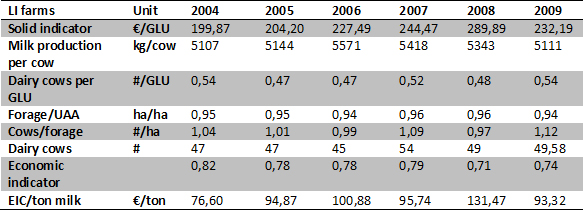
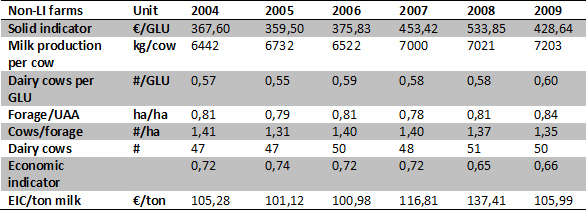
Evidently, LI farms use considerably less inputs than the other farms. LI farms are more specialized than non-LI farms, these farms have also some cash crops and this group uses the forage more intensive than the LI group. However, both groups have a similar number of dairy cows. LI farms have a lower milk production per cow and use the fodder area less intensive than the non-LI farms.
Such comparisons, as demonstrated above for Belgium, differ from country to country. For example, while the number of dairy cows is approximately the same for the two typical farms in Finland, Belgium and Spain, this is not the case in the UK, where the non-LI typical farm has more dairy cows. This results in higher external input cost per ton milk on the LI typical farms.
Milk production per cow is on the LI typical farm of Finland higher than the milk production on non-LI typical farms in the other countries.

Ongoing research with the typical farms
Above description of typical farms is based on the key figures, used for delimitating the homogenous groups behind the LI typical farm. These descriptions will now be enlarged with other FADN data and reasonable assumptions on physical features (of which data are lacking in FADN) concerning, for example, concentrate use, possible ongoing pasture strategies, biodiversity or N balance. Through this type of descriptions, the typical farms intend to be a better anchor for information flow between the different modelling levels. They provide a template for linking reasonable assumptions to the existing description and this will also facilitate the design of novel strategies to competitive sustainability.
AUTHORS
